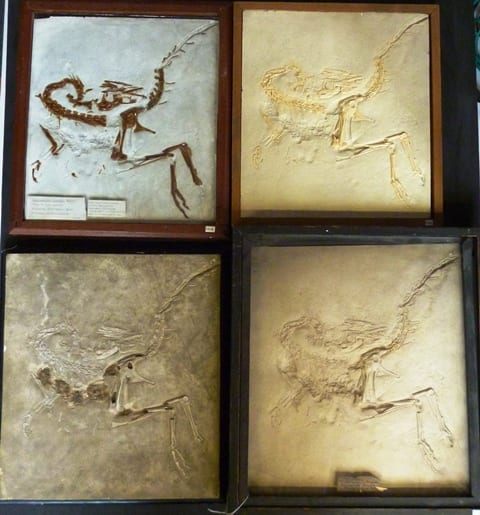Specimen of the Week: Week 183
By Mark Carnall, on 13 April 2015
 This week’s specimen of the week is another specimen highlighted in our current exhibition Strange Creatures: The Art of Unknown Animals and yet another dinosaur specimen from me. In our exhibition about representing animals through art and science, this specimen is in a case about how understanding of extinct animal biology has changed through the discovery of new fossils and advances in analytical techniques and tools.
This week’s specimen of the week is another specimen highlighted in our current exhibition Strange Creatures: The Art of Unknown Animals and yet another dinosaur specimen from me. In our exhibition about representing animals through art and science, this specimen is in a case about how understanding of extinct animal biology has changed through the discovery of new fossils and advances in analytical techniques and tools.
Today’s specimen is often described as chicken-sized which is one of the go-to standard measurements of animals in popular culture, the full scale goes; mouse-sized, chicken-sized, turkey-sized, terrier-sized, volkswagen-sized then various dimensions expressed in double-decker buses ending with Olympic swimming pools and football pitches. There is a separate system for brain sizes oriented around fruit, nut and sporting ball sizes.
This week’s specimen of the week is…
** A cast of Compsognathus longipes**
1) Dainty jaw The first specimen of Compsognathus, of which this is a cast- see more below, was found in Jurassic deposits in Germany and described in 1861. A second specimen was discovered in France in 1971. The name Compsognathus comes from Greek and means dainty jaw, probably on account of the lovely preservation. The original specimen was discovered in the Solnhofen Lagerstätte, a site of excellent preservation that also yielded beautifully preserved fossils of sometimes bird, sometimes not Archaeopteryx. From the preserved stomach contents of the two specimens of Compsognathus we know that they ate small lizards.
2) At least I have chicken As I mentioned above, Compsognathus is often described as chicken-sized* which isn’t an especially useful comparison as chickens vary wildly in size particularly the sort found in supermarkets depending on hormone and other feed supplements. In any case Compsognathus is probably slightly larger than chicken-sized as the original specimen is thought to be a juvenile. In the museum today this specimen is often overlooked as a dinosaur because of it’s size. Many of our visitors assume our articulated rhinoceros must be a dinosaur because it is big (and all dinosaurs are big right?) and this cast like our Hypsilophodon cast don’t match the expectation.
3) Record-breaking dinosaur Compsognathus has held some accolades over time. It was one of the first near-complete theropod dinosaurs ever discovered and for a long time held the record for being the smallest known dinosaur (excluding of course, as ever, birds). Subsequently, a number of smaller dinosaur species have been discovered from Asia.

The Grant Museum’s collection of Compsognathus longipes casts. Clockwise from top left they are: LDUCZ-X418 Cadburygnathus, LDUCZ-X798 Pearlygnathus, LDUCZ-X216 Pastygnathus and LDUCZ-X797 Mankygnathus
4) Cast off Given the rarity of actual Compsognathus remains, the original specimen is probably one of the most widely reproduced specimens of all time. Every natural history museum and university department worth its salt procured a cast for display, research or teaching. The Grant Museum alone has four casts and we’re a comparatively small natural history museum. However, given that casts, models and replicas often carried an inferior status to the ‘real deal’ museums didn’t keep good records on where their casts came from or whether they were cast from the original or a cast of a cast. This is important as the quality and accuracy varies depending on when they were taken and how many degrees removed from the original they are.
5) Six degrees of Compsognathus. We took this week’s specimen to the Cheltenham Science Festival one year and were surprised to meet someone there who recognised it and claims that he made this cast and others we have in the collection, created from the original fossils whilst they were on loan to Birkbeck College. Not only did we not know that this specimen came from Birkbeck but that it may be a ‘first-generation’ cast makes it more scientifically valuable, although I’ve not been able to confirm when and why the original fossil was at Birkbeck, if it was at all.
Mark Carnall is the Curator of the Grant Museum of Zoology
* Stephen Jay Gould wrote an excellent essay called The Case of the Creeping Fox Terrier Clone on how ambiguous size comparisons get repeated unscrutinised even if they are wrong or aren’t useful in reference to Henry Fairfield Osborne comparing the extinct early perissodactyl Hyracotherium to the size of a fox terrier. This comparison was then widely repeated in text books and reference literature despite the fact that the size comparison was quite a bit off and most people don’t actually know how big a fox terrier is.
 Close
Close


